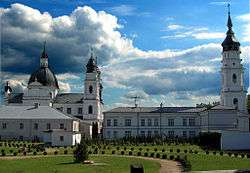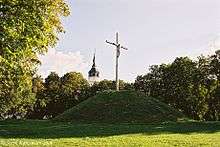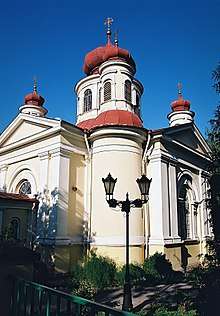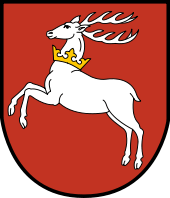Chełm
Chełm (Polish: [xɛwm] (![]()
Chełm | |
|---|---|
 Cathedral on Góra Chełmska | |
 Flag  Coat of arms | |
 Chełm  Chełm | |
| Coordinates: 51°07′56″N 23°28′40″E | |
| Country | |
| Voivodeship | |
| County | city County |
| Established | 10th century |
| Town rights | 1392 |
| Government | |
| • Mayor | Jakub Banaszek (PJG) |
| Area | |
| • City | 35.28 km2 (13.62 sq mi) |
| Highest elevation | 153 m (502 ft) |
| Lowest elevation | 80 m (260 ft) |
| Population (2015) | |
| • City | 63,949[1] |
| • Density | 1,812/km2 (4,690/sq mi) |
| • Metro | 78,419 |
| Time zone | UTC+1 (CET) |
| • Summer (DST) | UTC+2 (CEST) |
| Postal code | 22-100 to 22-118 |
| Area code(s) | +48 082 |
| Car plates | LC |
| Website | http://www.chelm.pl |
The city is of mostly industrial character, though it also features numerous notable historical monuments and tourist attractions in the Old Town. Chełm is a multiple (former) bishopric. Its name comes from the Proto-Slavic or Celtic word "cholm", a hill, in reference to the Wysoka Górka fortified settlement.[2] Chełm was once a vibrant multicultural and religious centre populated by Roman Catholics, Orthodox Christians and Jews. The population was homogenized after World War II.
History
The first traces of settlement in the area of modern Chełm date back to at the least 9th century. The following century, a fortified town (gord) was created and initially served as a centre of pagan worship. The etymology of the name is unclear, though most scholars derive it from the Proto-Slavic noun denoting a flat hill. The town's centre is located on a hill called góra chełmska. However, it is also theorized that the name is derived from some Celtic root. In 981 the town, then inhabited by the Eastern Slavic tribe of Buzhans, was made a part of Kievan Rus', along with the surrounding Cherven Towns. According to a local legend, Vladimir the Great built the first stone castle there in 1001. Following the Polish capture of Kiev in 1018, the region became part of Poland until returning to Kievan rule in 1031.
In 1235, Danylo Romanovych of Halych granted the town a city charter and moved the capital of his domain in 1241–1272 after destruction of Halych by Mongols in 1240–1241. Danylo also built a new castle atop the hill in 1237, one of the few Ruthenian castles that withstood Mongol attacks, and established an Orthodox eparchy (diocese) centered at the Basilica of the Birth of the Virgin Mary. Until the 14th century, the town developed as part of Kingdom of Galicia–Volhynia and then as part of the short-lived Princedom of Chełm and Belz (see Duchy of Belz). In 1366, king Casimir III the Great of Poland took control of the region after his victory in the Galicia–Volhynia Wars. On 4 January 1392, the town was relocated and granted rights under Magdeburg Law, with vast internal autonomy and the town saw an influx of Polish and other Catholic settlers.
A Latin Rite Catholic diocese of Chełm was created in 1359, but its seat was moved to Krasnystaw after 1480.[3] Renamed as Diocese of Chełm–Lublin in 1790, it was suppressed in 1805, but since 2005 Chełm is nominally restored and listed by the Catholic Church as Latin titular bishopric.[4]
The Orthodox bishopric entered communion with the see of Rome in the late 16th century as Ukrainian Catholic Eparchy of Chełm–Bełz, retaining its Byzantine Rite, but in 1867 it became part of the imperial Russian Orthodox Church,[3] and is now the Archdiocese of Lublin and Chełm of the Polish Orthodox Church.
The town was the capital of a historical region of the Land of Chełm, administratively a part of the Ruthenian Voivodeship with the capital in Lviv (Lwów). The city prospered in the 15th and 16th centuries. It was then that The Golem of Chełm by Rabbi Elijah Ba'al Shem of Chelm became famous, but the city declined in the 17th century due to the wars which ravaged Poland. In the 18th century, the situation in eastern Poland stabilized and the town started to slowly recover from the damages suffered during the Swedish Deluge and the Khmelnytsky uprising. It attracted a number of new settlers from all parts of Poland, including people of Catholic, Orthodox, and Jewish faiths. In 1794, the Chełm Voivodeship was established. Chełm was one of the first towns to join the Kościuszko's Uprising later that year. In the Battle of Chełm of 8 June 1794, the forces of Gen. Józef Zajączek were defeated by the Russians under Valerian Zubov and Boris Lacy, the town was yet again sacked by the invading armies. The following year, as a result of the Third Partition of Poland, the town was annexed by the Austrian Empire.
Age of partitions
.jpg)
During the Napoleonic Wars in 1809, in the effect of the Polish–Austrian War, the town was briefly part of the Duchy of Warsaw. However, the Congress of Vienna of 1815 awarded it to Imperial Russia. The town entered a period of decline as the local administrative and religious offices (including the bishopric) were moved to Lublin. In the mid-19th century, the Russian Army turned the town into a strong garrison, which made the Russian soldiers a significant part of the population. The period of decline ended in 1866, when the town was connected to a new railroad. In 1875, the Uniate bishopric was liquidated by the Russian authorities and all of the local Uniates were forcibly converted to the Russian Orthodox Church. In the late 19th century, the local administrative offices were restored and in 1912 a local gubernia was created. During the Russian revolution of 1905 in the city was established the Ukrainian enlightenment society of Prosvita.
During the World War I in 1915 most of the Ukrainian and Russian population was evacuated to the Sloboda Ukraine and the Russian chernozem regions, after which percentage of the Polish population rose significantly. In 1918, following World War I and Poland regaining independence, the town became part of Lublin Voivodeship (1919–1939) in the Second Polish Republic.
World War II
.jpg)
On 27 September 1939 the invading Soviet Red Army occupied Chełm, but withdrew two weeks later in accordance with the German-Soviet Frontier Treaty. As early as 7–9 October 1939 the renamed city of Kulm was occupied by Germans forces.[5][6] At the beginning of the war, Chełm's population was around 33,000 of which 15,000 were Jewish. On Friday, 1 December 1939, at 8 o'clock, around 2000 Jewish men were driven at dawn to the market-square ("Okrąglak" or "Rynek") surrounded by the German SS formations and local indigenous officials.[7] They were forced on a death march to Hrubieszów. Hundreds were murdered on the march, others were tortured and beaten. They were marched to the Soviet border where they were forced to cross the river under gunfire. [8][9][10] Eventually perhaps 400 of the men survived the Death March and 1600 were slaughtered.[11]
In late 1940, Jews were confined to a small portion of Chełm, living in very overcrowded conditions, up to several dozen a room. Jews were conscripted for forced labor near Chełm and in other locations. The German Reich established 16 forced labor camps in the new Lublin district. Locals from neighboring villages and towns of Chełm also were forced to work in these camps. (also Khelm or Kulm in German), Some of the camps were connected to the main railroad line through a 40 km (25 mi) railroad branch line to the killing camps.
In 1942, during Operation Reinhard, the highly secretive Bełżec, Treblinka, and the Sobibór extermination camps were built near the forced labor camps. Their purpose was to murder all Polish Jews. [12] In May, 1942, 1000 elderly Chełm Jews were sent to the Sobibór extermination camp where they were immediately murdered. In August, 3000 to 4000 more were sent, including most of the children in the ghetto. In October, the SS and their Ukrainian auxiliaries rounded up and deported another 2000 to 3000 Jews to Sobibor. In November, the remaining Jews were marched to the railway station. Most were sent to Sobibor. Those in hiding were hunted, and the SS burned several ghetto buildings and killed many people who emerged from hiding. Some Jews remained in the ghetto as laborers, but they too were murdered in January 1943. There were only an estimated 60 Jews who survived the Holocaust Some survivors managed to find shelter in the Chełm Chalk Tunnels. However, as many as 400 others who fled to the east at the beginning of the war returned to Chełm but quickly moved on.[13]
Following the 1941 Operation Barbarossa the Germans established a POW camp in Chełm, called Stalag 319 for the Red Army soldiers captured in eastern Poland and modern Ukraine or Belarus, on top of prisoners brought in from the West (mostly France) for the total of some 200,000 until July 1944. In three years, some 90,000 prisoners lost their lives there. The monument commemorating the victims of Stalag 319 was unveiled in Chełm in May 2009 in the presence of foreign diplomats.[14]
From 1942 through to 1945, Chełm was one of numerous locations of the Volhynian massacres by death squads of OUN-UPA and the bands of Ukrainian nationalists. The city and its environs witnessed the revenge killings as well,[15][16] between Ukrainians and its Polish self-defence.[17][18] As noted by historians Grzegorz Motyka and Volodymyr Viatrovych, the subject is highly controversial, because in 1944, Roman Shukhevych, leader of OUN-UPA issued an order to fabricate proofs of Polish responsibility for war crimes committed there.[19][20]
Chełm in Jewish literature
By the end of World War II, only a remnant of Chełm's Jewish population of c. 18,000 survived. They managed to emigrate to Israel, North America, Central America, South America, or South Africa. Chełm became well-known thanks to Jewish storytellers and writers such as Isaac Bashevis Singer, a Nobel Prize-winning novelist in the Yiddish language, who wrote The Fools of Chełm and Their History (published in English translation in 1973), and the great Yiddish poet Ovsey Driz who wrote stories in verse. Notable adaptations of the Chełm Jewish folklore include the comedy Chelmer Khakhomim ("The Wise Men of Chelm") by Aaron Zeitlin, The Heroes of Chelm (1942) by Shlomo Simon, published in English translation as The Wise Men of Helm (Simon, 1945) and More Wise Men of Helm (Simon, 1965), as well as the book Chelmer Khakhomim by Y. Y. Trunk.[21] Allen Mandelbaum's "Chelmaxioms : The Maxims, Axioms, Maxioms of Chelm" (David R. Godine, 1978) treats the wise men of the Jewish Chełm as scholars who are knowledgeable but lacking sense. The Chełm stories emulate the interpretive process of Midrash and the Talmudic style of argumentation,[22] and continue the dialogue between rabbinic texts and their manifestation in the daily arena.[23][24] The seemingly tangential questioning that is typical of the Chełm Jewish Council can be interpreted as a comedic hint at the vastness of Talmudic literature. The combination of paralleled argumentation and linguistic commonality allows the Jewish textual tradition, namely Talmudic, to shine through Chełm folklore.[25]
Population


After Poland's independence, the Polish census of 1921 found a population of 23,221, with 12,064 Jews, 9,492 Roman Catholics (Poles), 1,369 Orthodox Christians (Ukrainian, Ruthenians and Belarusians) and 207 Lutherans (Germans).
In September 1939, at the onset of World War II, Jews constituted 60% (18,000) of the city's inhabitants.[26]
Sports
- Chełmianka Chełm – Polish football club, playing in the III liga
- AZS Chełm – women basketball team, 7th place in Sharp Torell Basket Liga in 2003/2004 season
Notable people
- Elijah Ba'al Shem of Chełm (1550–1583), notable Jewish rabbi
- Leon Fleischer (born 1928), pianist and conductor
- Ida Haendel (1928–2020), classical violinist
- Mykhailo Hrushevsky (1866–1934), Ukrainian historian and politician
- Renata Reisfeld (born 1930), Israeli chemist
- Rose Schneiderman (1882–1972), feminist and labor leader
- Joseph Serchuk (1919–1993), Sobibor uprising survivor and Jewish partisan
- Józef Szydłowski (1896–1988), aircraft engine designer
- Szmul Zygielbojm (1895–1943), Bund leader
- Anna "Ania" Dąbrowska (born 1981), singer and songwriter
Politics
Most influential Members of Parliament (Sejm) elected from the Biała Podlaska/Chełm/Zamość constituency (2006) included: Badach Tadeusz (SLD-UP), Bratkowski Arkadiusz (PSL), Byra Jan (SLD-UP), Janowski Zbigniew (SLD-UP), Kwiatkowski Marian (Samoobrona), Lewczuk Henryk (LPR), Michalski Jerzy (Samoobrona), Nikolski Lech (SLD-UP), Skomra Szczepan (SLD-UP), Stanibuła Ryszard (PSL),[27] Stefaniuk Franciszek (PSL), Żmijan Stanisław (PO) and Matuszczak Zbigniew (SLD).
Symbols
The flag of Chełm is a rectangle with 2:3 proportions, divided into two parallel, horizontal stripes of the same width (upper - white, lower - green). On the upper strip, in the center, there is the coat of arms of Chełm.
International relations
Twin towns – Sister cities
Chełm is twinned with:
References
- Notes
- "Chełm". www.polskawliczbach.pl (in Polish). Retrieved 2 February 2017.
- "Historia miejscowości - Informacje o mieście - Chełm - Wirtualny Sztetl". www.sztetl.org.pl (in Polish). Retrieved 2 February 2017.
- Halina Lerski, Historical Dictionary of Poland, 966–1945 (ABC CLIO 1996 ISBN 978-0-313-03456-5), p. 63
- Annuario Pontificio 2013 (Libreria Editrice Vaticana 2013 ISBN 978-88-209-9070-1), p. 868
- "Communal History - Chelm". Encyclopedia Judaica 1972, Keter Publishing House Jerusalem Ltd. Chelmer Organization of Israel. Retrieved 14 July 2013.
- "The Jews of Chełm & Escape from Borek Forest". Holocaust Education & Archive Research Team. www.HolocaustResearchProject.org 2008. Retrieved 14 July 2013.
- Bakalczuk-Felin, Meilech and Moshe M. Shavit. "Preface". The History of the Jews in Chelm. JewishGen, Inc. Retrieved 14 July 2013.
- Berkenstat Freund, Gloria and Ben-Tzion Bruker, Lazar Kahan, Y. Herc, Yitzhak Groskop, J. Grinszpan. "The Slaughter of the Jews in Chelm". Destruction of Chelm. 2013 by JewishGen, Inc. Retrieved 14 July 2013.
- Meltzer, Rae and Dr. Philip Frydman. "The Beginning and the History of a Yiddish Community". The History of the Jews in Chelm. 2013 by JewishGen, Inc. Retrieved 14 July 2013.
- Berkenstat Freund, Gloria, Irene Szajewicz and Gitl Libhober. "Witness Testimony by Gitl Libhober". DESTRUCTION OF CHELM. 2013 by JewishGen, Inc. Retrieved 14 July 2013.
- Megargee, Geoffrey (2012). Encyclopedia of Camps and Ghettos. Bloomington, Indiana: University of Indiana Press. p. Volume II 623. ISBN 978-0-253-35599-7.
- Aktion Reinhard Camps. Sobibor Labour Camps. 15 June 2006. ARC Website.
- Dobroszycki, Lucjan (2012). Survivors of the Holocaust. Bloomington, Indiana: University of Indiana Press. p. 72, 79. ISBN 1-56324-463-2.
- Jacek Barczyński (8 May 2009). "Obóz Stalag 319". Media Regionalne. Dziennik Wschodni. Archive.is. Retrieved 10 August 2013.
- Ihor Ilyushin (11 September 2009), Розділ 5. Бойові дії ОУН і УПА на антипольському фроиі. Chapter 5, pp. 264–266, in the Ukrainian language. From: Organization of Ukrainian Nationalists and the Ukrainian Insurgent Army. Institute of Ukrainian History, Academy of Sciences of Ukraine.
- Grzegorz Motyka, Zapomnijcie o Giedroyciu: Polacy, Ukraińcy, IPN
- "Orthodox New Martyrs canonized". The Byzantine Forum 2013. Retrieved 14 July 2013.
- Marples, David R. (2007). Heroes and villains: creating national history in contemporary Ukraine. Budapest: Central European University Press. p. 210.
- Motyka, Grzegorz (2011). Od rzezi wołyńskiej do Akcji "Wisła". Kraków: Wydawnictwo Literackie. p. 228. ISBN 978-83-08-04576-3.
Sprawa dotyczyła wsi wymordowanych przez UPA.
- Jasiak, Marek. "Overcoming Ukrainian Resistance", in Ther, Philipp; Siljak, Ana (2001). Redrawing nations: ethnic cleansing in East-Central Europe, 1944–1948. Oxford: Rowman & Littfield. p. 174.
- "The Myth of Chełm in Jewish Literature"
- Rogovin, Or. 'Chelm as Shtetl.' Prooftexts. 29.2 (2009): 242–272. Print.
- Krakowski, Stefan, and Aryeh-Leib Kalish. 'Chelm.' Encyclopaedia Judaica. Ed. Michael Berenbaum and Fred Skolnik. 2nd ed. Vol. 4. Detroit: Macmillan Reference USA, 2007. 588–589. Gale Virtual Reference Library. Web. 5 March 2013.
- Herr, Moshe David. 'Midrash.' Encyclopaedia Judaica. Ed. Michael Berenbaum and Fred Skolnik. 2nd ed. Vol. 14. Detroit: Macmillan Reference USA, 2007. 182–185. Gale Virtual Reference Library. Web. 10 March 2013.
- Harshav, Benjamin. The Meaning of Yiddish United States of America: University of California Press, 1990. 112. Print.)
- Rosemary Horowitz. Memorial Books of Eastern European Jewry: Essays on the History and Meanings of Yizker Volumes. McFarland. 2011. pp. 73–74
- Link in Polish Archived 27 June 2006 at the Wayback Machine with relevant pop-ups.
- "City Directory". Sister Cities International. Archived from the original on 8 January 2015. Retrieved 25 March 2014.
External links
![]()
- (in English) Chełm official English-language home page
- (in Polish) eChełm.pl
- (in Polish) Chełm Online
